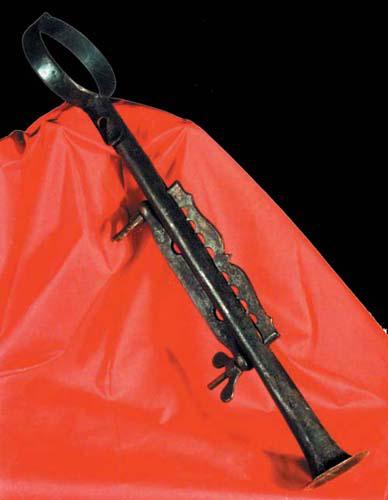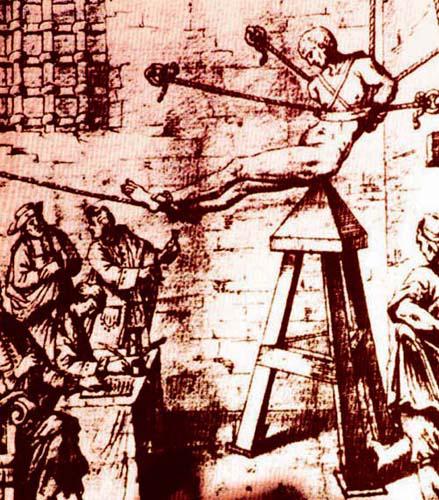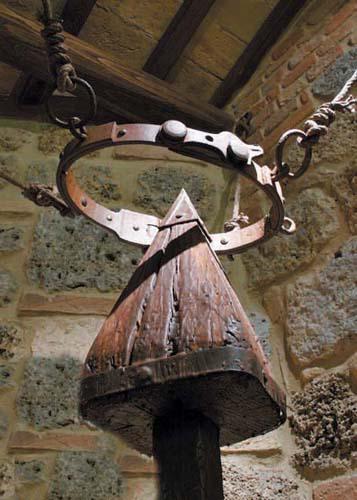The Big Book of Pain: Torture & Punishment Through History (51 page)
Read The Big Book of Pain: Torture & Punishment Through History Online
Authors: Daniel Diehl

BOOK: The Big Book of Pain: Torture & Punishment Through History
12.88Mb size Format: txt, pdf, ePub

The Shrew’s Fiddle, or
Halsgiege
(neck-violin) is akin to other devices meant to humiliate and torture a person. The head went through the larger hole with the wrists clamped within the two smaller holes. In this way the victim could be easily directed and pulled along. Some examples were chained together near the ‘neck’ of the violin, still others consisted of one long ‘standing pillory’ of two fiddles joined neck to neck by a solid piece of wood.
An iron version was widely used during the years of slavery in the United States until its abolition in 1865.
(See also: stocks; pillory; drunkard’s cloak; brank; noisemaker’s fife, masks of shame or infamy; and the Chinese Cangue)


This device is known as the noise-maker’s fife or flute. A variety of instruments of this form (trumpet, trombone, oboe and recorder made of wood or brass or iron) are known to have existed in the sixteenth–seventeenth centuries – though earlier and later representations can be found. The iron collar was locked around the victim’s neck, and his or her fingers, posed like those of a playing musician’s under notches in the long vice, were squeezed with a force varying from uncomfortable to unbearable.
This was essentially a form of pillory
(see also pilliwinkes)
, of exposure to public ridicule, with all the customary painful and sometimes fatal consequences that marked the fate of all those treated in this manner. It was inflicted for relatively minor crimes and sins such as disturbing the peace. In Italy, it was often meted out to those guilty of
baldoria e baccano
– ‘revelry and din’ – in front of a church during holy functions. The term ‘
piffero del baccanaro
’ or ‘noise-maker’s fife’, appears in several eighteenth-century Bolognese documents.






The horrific procedure of torture by means of the Judas Cradle has remained essentially unchanged from the Middle Ages to the present day. The victim is hoisted up in the manner shown in the illustration (opposite below), and lowered onto the point of the pyramid in such a way that his or her weight rests on the sharpened point. This point would be positioned at the anus, in the vagina, beneath the scrotum or under the coccyx.
The torturer could then, according to the pleasure of the interrogators, vary the pressure from zero to that of total body weight (or even greater through the addition of weights). The victim could furthermore be rocked or made to fall repeatedly onto the point. And, of course, they could be left in this ‘perched’ position for indefinite periods of time.
The Judas cradle was also known as
culla di Giuda
in Italian and
Judaswiege
in German, but in French it was referred to as
la veille
, ‘the wake’ or ‘nightwatch’ (this presumably because victims would be left in this precarious suspended anguish overnight). In the modern world, this method of torture and interrogation has been known to be used in Latin America (and elsewhere) both with and without ‘improvements’ such as electrified waist rings and bladed ‘points’ to the apex of the pyramid.


Other books
Her Knight in the Outback by Nikki Logan
Alfred Hitchcock by Patrick McGilligan
Angel's Breath (Fallen Angels - Book 2) by Valmore Daniels
Jaded 2: Broken Love Series by Renee Tyler
To Journey Together by Burchell, Mary
Ghost Invasion by Zilpha Keatley Snyder
Lessons I Never Learned at Meadowbrook Academy by Liz Maccie
Chosen by Fate by Virna Depaul
Everything Bad Is Good for You by Steven Johnson
Gargantuan by Maggie Estep
